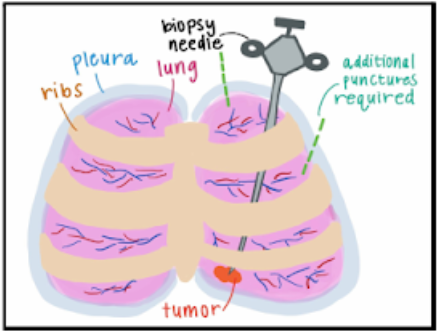Increasing the Safety of Percutaneous Lung Biopsies
Team: Advanced BME Design Team: PneuTech
Program:
Biomedical Engineering
Project Description:
A percutaneous core needle lung biopsy is a minimally invasive procedure by which a sample of abnormal lung tissue is obtained through a needle inserted directly into the targeted site of the lung using imaging guidance.The most common complication during this procedure is pneumothorax, a collapsed lung, which occurs in 1 in 5 patients. With over 100,000 procedures performed in the United States alone, pneumothorax contributes to over $120 million in annual hospital costs. Thus, there is a critical need to improve the safety of percutaneous lung biopsies. The current standard of care utilizes a straight needle guided by computed tomography (CT), making it a challenge to direct the needle to the target site while navigating around critical structures, such as major blood vessels, airways, and ribs (Figure 2). Therefore, additional pleural punctures within a single biopsy or a repeat biopsy may be necessary to obtain an adequate sample, increasing the likelihood of pneumothorax. Our solution addresses these issues via a novel needle system equipped with the ability to access any target site in any location while minimizing the number of pleural punctures. By enabling safer high-yield lung biopsy procedures, our device has the potential to revolutionize the lung biopsy space.
Team Members
-
[foreach 357]
-
[if 397 not_equal=””][/if 397][395]
[/foreach 357]
Project Mentors, Sponsors, and Partners
-
Clinical Mentor: Dr. Robert Liddell, Ph.D.
-
Faculty Mentor: Shababa Matin
-
Dr. Harjit Singh, M.D.
-
Rich Middlestadt
-
Dr. Supriya Munshaw, Ph.D.
-
Bibhav Poudel
-
Dr. Kimberley Studeman, M.D.
-
Ian McLane
-
Sarah Lee
Course Faculty
-
[foreach 429]
-
[if 433 not_equal=””][/if 433][431]
[/foreach 429]
